Review: L.A. gallery-going during Omicron isn’t optimal but offers excellent art along the way
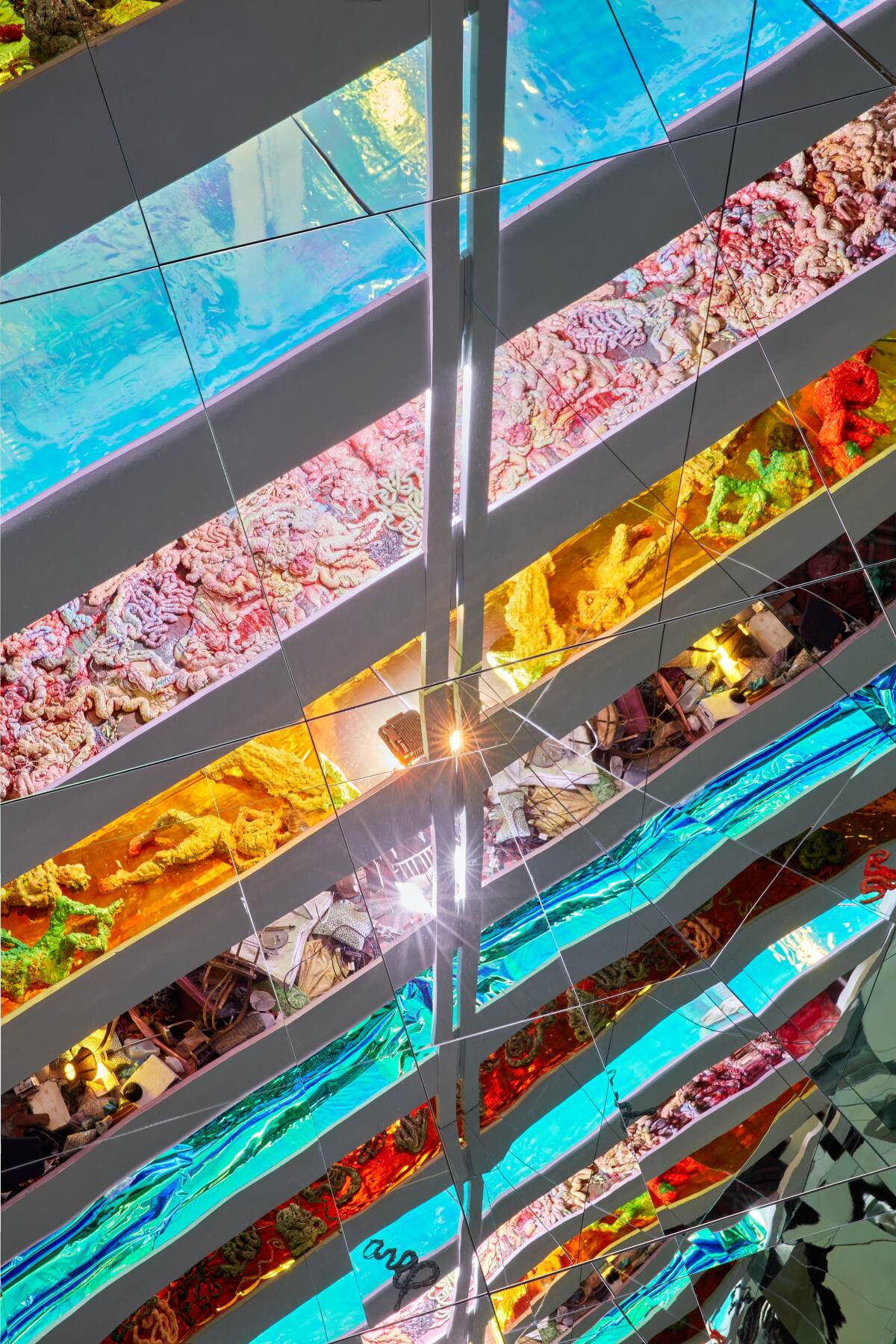
- Share via
As the pandemic rolls on, spreading the Omicron variant far and wide, visiting art galleries remains a less-than-satisfying endeavor.
To its advantage, gallery-going offers a better bet against viral transmission than witnessing most performing art, since a gallery doesn’t require sitting in one place amid a throng for most of a couple of hours, but it isn’t yet optimal. And though COVID cases are in steep decline, the death rate remains disturbingly high.
Recently, I went to a dozen galleries — N95-masked, scheduled for a couple of appointments during the usually uncrowded morning and armed with triple-vaccination proof — seeing some excellent art along the way. I started off at L.A. Louver in Venice, where a fine, compact survey of 17 paintings by the late British artist Leon Kossoff (1926-2019) was coordinated with Annely Juda Fine Art (London) and Mitchell-Innes & Nash (New York). The show accompanies publication of a 640-page catalogue raisonné of the exceptional artist’s oil paintings.
There was something unintentionally fitting about seeing Kossoff’s complex, sobering art under our currently disrupted circumstances. The show’s earliest painting, “Seated Woman” (1957), is a 5-foot-tall panel laden with pounds and pounds of thick, dark paint. Kossoff dragged his brush through the chocolate brown mud, exposing rich tones of purple, crimson and forest green buried within, literally carving out the linear form of a dozing figure, hands clasped in her lap, mouth a hooked slash.
The carved channels delineate in negative space the pendulous breasts, somnolent grimace and agitated body. Owing something to Willem de Kooning’s celebrated paintings of women from a few years before, she’s the modern image of a prehistoric Venus, ancient and lifeless yet poised for formidable rebirth.
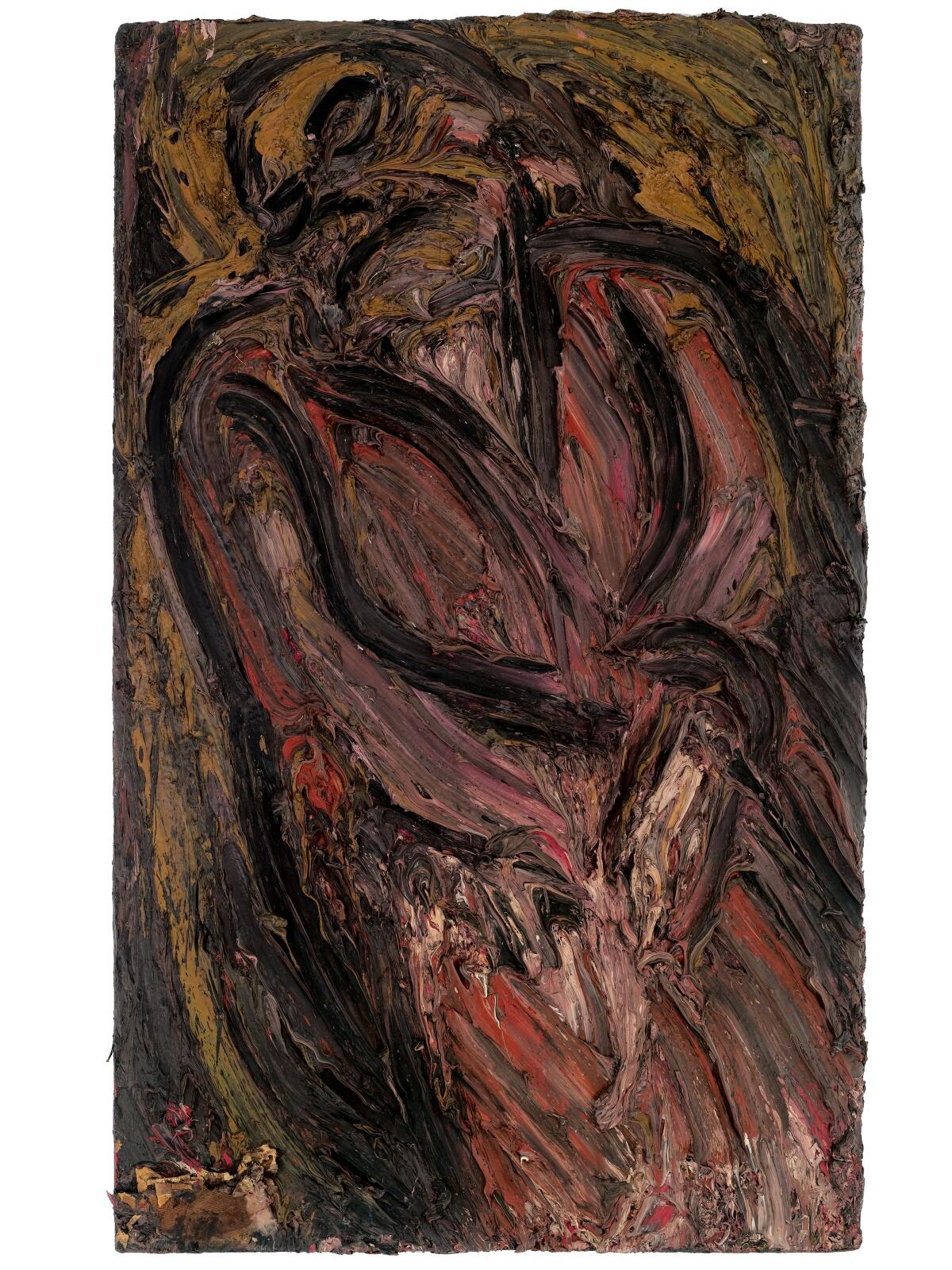
Catalog author Andrea Rose, former director of visual arts at the British Council, chronicles the harrowing history of the painting’s sitter, a distant relative of the artist, who survived anti-Jewish pogroms in western Russian provinces. The visceral painting, which dates from London’s struggle to rebuild from the wreckage of World War II, is an extraordinary object, packed with churning power.
Upstairs, the gallery has installed an independent show of two Kossoff paintings, 12 etchings and two drawings, all related to classical French Baroque pictures by Nicolas Poussin, which the artist had studied in the collection at London’s National Gallery. In Kossoff’s expressionist reworkings, it’s often hard to tell whether we are witnessing a joyful bacchanal or a deadly massacre, a revelry or a riot. They’re especially worth seeing now, as the Getty Museum prepares to launch the exhibition “Poussin and the Dance” on Feb. 15, including the two works that inspired Kossoff.
Just a few galleries that I visited (including Louver) asked for vaccination proof at the entry, an omission that ordinarily would make me grimace. (Usually, I respond with thanks when asked for mine, as it means the venue is behaving responsibly about public health.) Some galleries still recommend making an appointment to visit, although many are fine with walk-ins. Never on my rounds was there more than one or two other visitors present — and most often none — while gallery staff everywhere was masked.
Two galleries were locked up tighter than a drum when I arrived (during regular midweek business hours), both with notes taped to the front door. “At lunch. Back in 20 minutes” said one, without any timestamp to make it possible to know whether the wait would be one minute or 19; so, I left.
The other instructed “For entry call” this phone number, which got no answer; I left again.
Some art seemed to reflect the extended quarantine experience of the last two years. At Roberts Projects, the straightforward yet eccentric glimpses of suburban street life in Ed Templeton’s closely observed paintings, drawings and photographs are like scenes witnessed while driving around alone.
A painting of a man seated benignly on a bus bench becomes inexplicably ominous as we watch him watch two young women ride by on a bicycle. A new collage of decade-old photographs of “Zealots With Crosses, Huntington Beach, 2012,” radiates an end-times vibe, its black-and-white juxtaposition of pleasure-seeking beach bathers and evangelical religious fanatics artfully torn in two.
Brooklyn’s Eddie Martinez, for his second L.A. solo show at Blum & Poe, continues to revisit a 1980s painting style for what could be called Neo-neo-expressionism. The paintings’ large-scale format — 10-foot and 12-foot canvases are common — offers a big field to merge figurative and abstract forms via thick, gestural, improvisational mark-marking.
Fragile butterflies or moths made muscular in galumphing paint are a recurrent subject. The most engaging, however, is a mammoth picture that zeroes in on a child’s toys strewn across the floor, amplifying the knowledge and sophistication acquired through play as painting’s primary motivator.
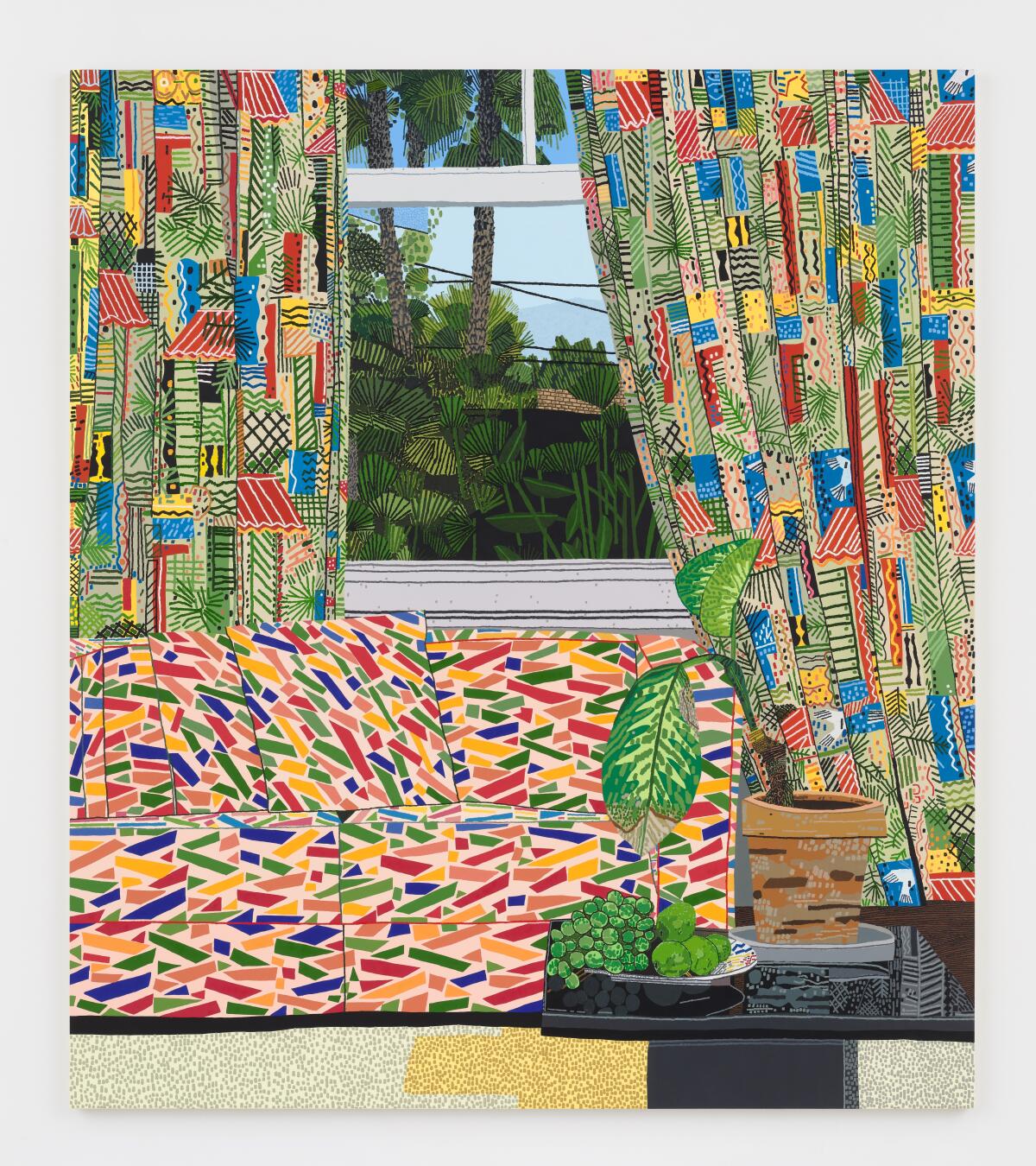
New paintings of abundant garden greenery and of dogs — a hugely fluffy Chow Chow, some poodles, and a terrier or two — by Jonas Wood at David Kordansky Gallery are heavy on confident design but light on durable visual appeal. (A friend describes Wood’s bloodless staccato brushwork as “typewriter-like.”) They look suitable for a snappy spring cover of the New Yorker magazine, prepping locals for summer vacation on Martha’s Vineyard or in the Hamptons.
The only work that grabs attention and holds it is the 9-foot-tall “Patterned Interior With Mar Vista View,” a marvelous little organic landscape seen out a big window and framed by an uproarious upholstered sofa and drapes, rendered in a geometric riot of multicolored hues. Carefully controlled delirium is a bracing incongruity. Think Matisse on acid in Nice.
At Night Gallery’s newly expanded downtown outpost on Imperial Street, L.A.-based Samara Golden has constructed a theatrical tour de force — one that seems wholly informed by our pandemic time. Climb up to a mezzanine and look inside a large, mirrored, trapezoidal space, which seems to expand interminably.
The mirrors reflect two full-height and two half-height stages. The rectangular spaces are stuffed with a variety of objects — a wriggling mass of snakes and crabs; a rippling metallic-blue tarp, which suggests a flood; a ruined living room, furniture upended every which way; a tangle of intestinal viscera, and more. The mirror reflections transform each white, Minimalist proscenium stage into the illusion of a full floor inside a building, each stacked one atop another into infinity.
The higher and lower the reflected illusion goes, the wobblier and more distorted the mental landscape becomes. This “indoor skyscraper” becomes a convulsive landscape of psychic disorder, ruin piled atop chaos.
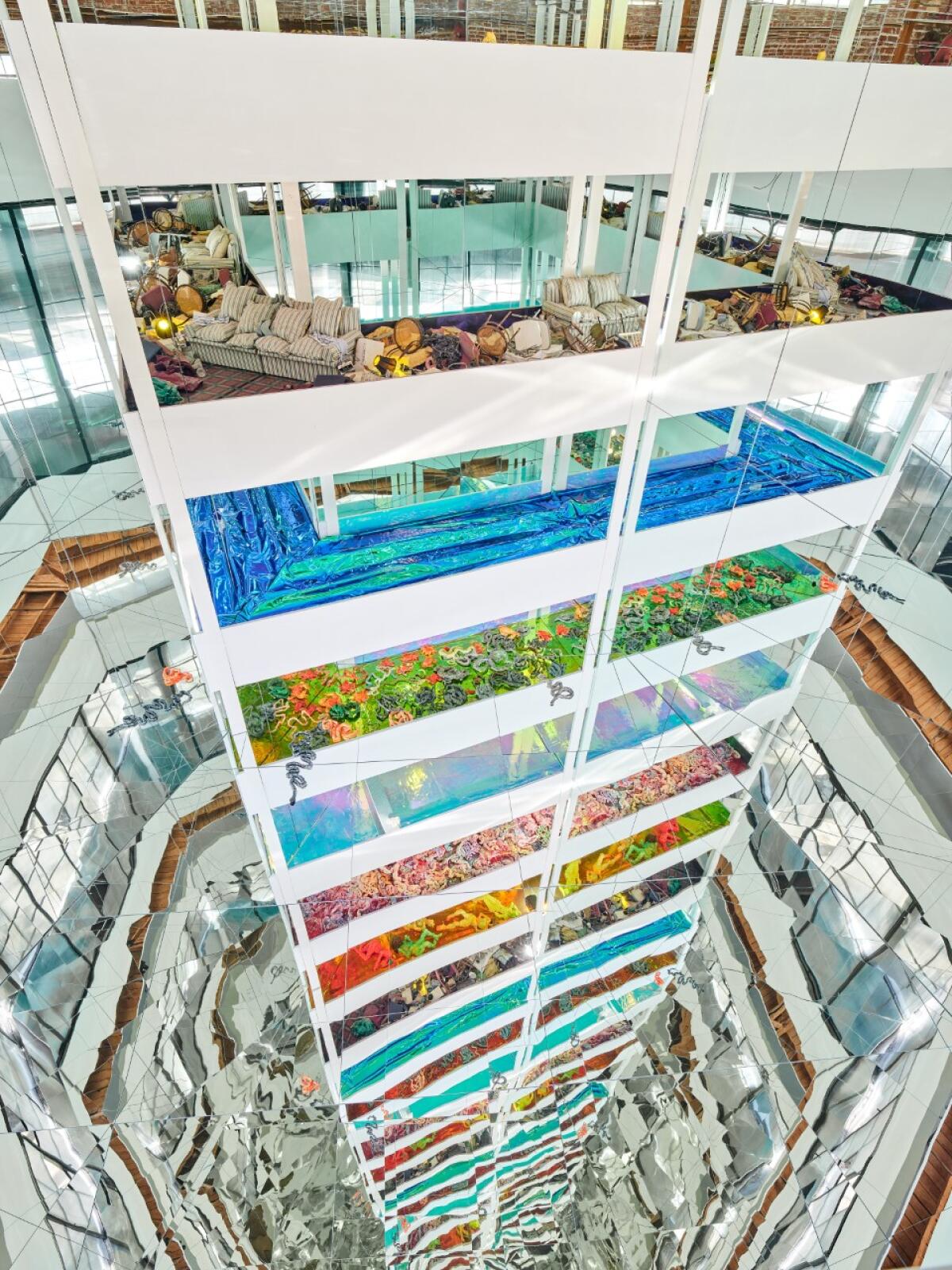
One great thing about the impressive composition is that Golden exposes all the visual tricks that make the installation work; but the space is so densely packed, so tweaked and twisted in concert with the mirrors, that getting a steady handle on what you’re seeing keeps slipping away, just out of reach.
Titled “Guts,” Golden’s installation is an offspring of Yayoi Kusama’s wildly popular mirrored infinity rooms. But Golden injects vertiginous nausea into Kusama’s gaga wonderment, which complicates the experience. The playful awe remains, but the sensation is equivocal — a stewed conflict that feels just right for our bewildering moment, when climate catastrophe battles for attention with ongoing mass death.
At Wilding Cran, several blocks away, Jeremy Everett’s poignant, strangely tender mixed media works look nothing like Golden’s, but the delicate layering and ephemerality inherent in his process result in paintings that look beautiful and exhausted. Bruised and wounded, they’ve been through a lot.
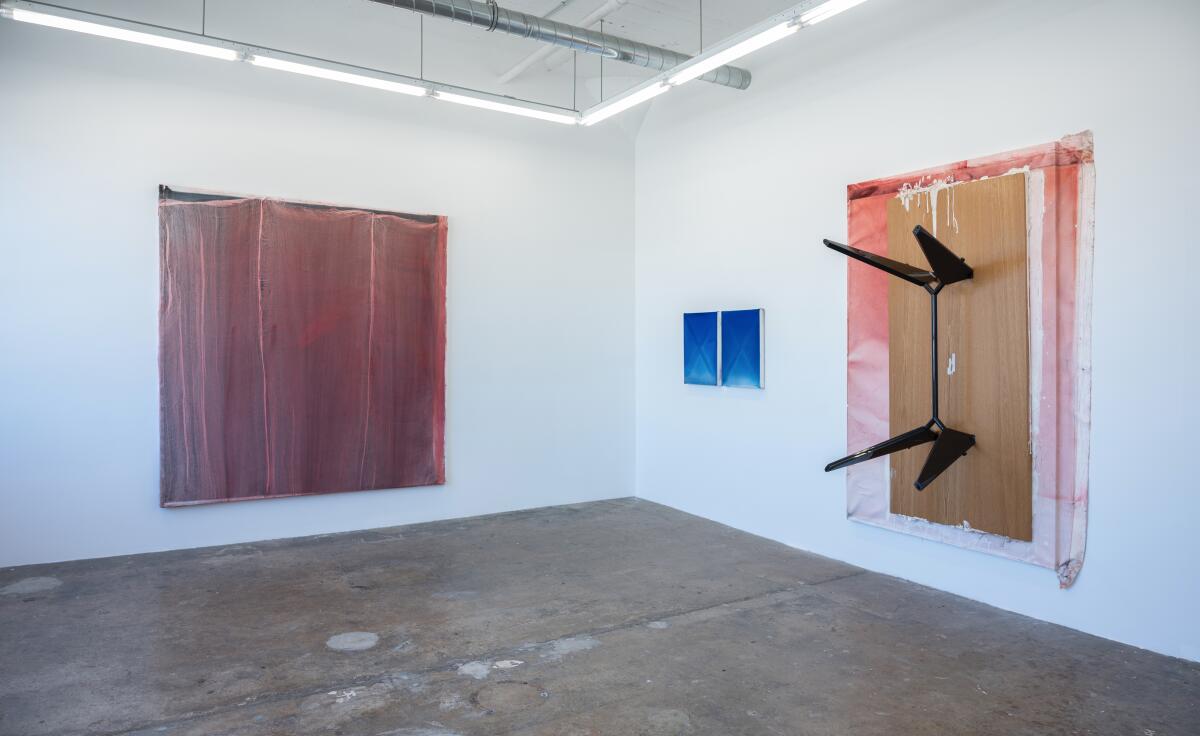
Large sheets of cheesecloth affixed to surfaces gently sprayed with a purplish mix of red and blue color, sometimes overlaid with smoky black, do double duty. They’re bandages that also evoke the woven-cotton canvas of the painting underneath, a scabbed support that is coming undone.
In one, an entire table is stuck to the surface, as if the worktop on which Everett painted the canvas got inextricably entangled in it. The distinctive butterfly legs jutting out indicate the furniture is by self-taught Modernist French designer Jean Prouvé (Everett splits his time between Los Angeles and Paris). The Modern world, like the canvas, flails.
At the Greenhouse, an annex in Vielmetter Los Angeles’ parking lot, Nicole Eisenman’s alarming plaster sculpture of a big, burly man with a blank face smeared in silver rides on the back of another beefy guy down on all fours, his hands and feet sullied in grime. The pointedly titled “Man at the Center of Men,” shown at the 2019 Whitney Biennial, is capped off by a pair of mirrored trash-can lids, held up as crashing cymbals with which the preening rider regards himself.
In a brilliant twist, spotlights reflecting off the mirrors cast the crude rider’s profile in shadow overhead on the ceiling, the dark silhouette framed by a luminous halo. Eisenman deftly topples the grandiose tradition of man-on-a-horse monuments, her “Man at the Center of Men” emerging as more a dull brute astride a subservient fellow donkey than a triumphal leader.
The sculpture resonates, dating from deep in the darkest days of the Trump administration, just before colossal White House incompetence sent deadly disease rocketing through society.
Pre-pandemic pleasures around uncomplicated gallery-going are unlikely to return for some time. There is art worth seeing, but it’s not easy to do.

The galleries
L.A. Louver, 45 N. Venice Blvd., (310) 822-4955, through March 26. lalouver.com
Roberts Projects, 5801 Washington Blvd., Culver City, (323) 549-0223, through March 5. robertsprojectsla.com
Blum & Poe, 2727 S. La Cienega Blvd., Culver City, (310) 836-2062, through Feb. 26. blumandpoe.com
David Kordansky Gallery, 5130 W. Edgewood Place, (323) 935-3030, through March 5. davidkordanskygallery.com
Night Gallery, 2050 Imperial St., (323) 589-1135, through March 26. nightgallery.ca
Wilding Cran Gallery, 1700 S. Santa Fe Ave., No. 460, (213) 553-9190, through March 12. wildingcran.com
Vielmetter Los Angeles / Greenhouse, 1700 S. Santa Fe Ave., (213) 623-3280, through Feb. 20. vielmetter.com
More to Read
The biggest entertainment stories
Get our big stories about Hollywood, film, television, music, arts, culture and more right in your inbox as soon as they publish.
You may occasionally receive promotional content from the Los Angeles Times.











